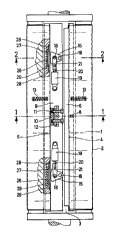Note: Claims are shown in the official language in which they were submitted.
- 6 -
THE EMBODIMENTS OF THE INVENTION IN WHICH AN EXCLUSIVE
PROPERTY OR PRIVILEGE IS CLAIMED ARE DEFINED AS FOLLOWS:
1. Device for mounting and tensioning elastic printing
plates on a plate cylinder of a rotary printing machine
having tensioning rails assigned to both ends of the
plate, whereby the tensioning rails are braced against
side walls of a cylinder channel for tensioning the
printing plate, and having means for stretching or
contracting a trailing end of said plate in axial
direction of the plate cylinder,
wherein a one-piece tensioning rail (9) is provided for
the trailing plate end (5),
wherein for the plate end (5) there is arranged a
clamping means (10) on the tensioning rail (9) in the
center region thereof, and
wherein in the end regions of the tensioning rail (9)
there are provided tensioning segments (15) which can be
actuated for stretching or contracting the plate end (5).
2. Device according to Claim 1,
wherein via bearing bolts (16) the tensioning segments
(15) are pivotally fastened to the tensioning rail (9)
and, for the printing plate end (5), are provided with
clamping areas (17) extending eccentrically to the
bearing bolt (16).
3. Device according to Claim 1 or 2,
wherein the tensioning segments (15) can be pivoted by
means of adjusting motors (19) which are pivotally
mounted at the tensioning rail (9).
- 7 -
4. Device according to Claim 1,
wherein the tensioning segments (15) include clamping
areas and opposite said clamping areas there are
inserted thrust bearings (22, 26) in the tensioning rail
(9), said thrust bearings supporting the axial movement
of the plate end (5).
5. Device according to Claim 4,
wherein the thrust bearings (22) consist of poly-
urethane and are provided with slits (25) arranged
transversely to the moving direction of the tensioning
segments (15).
6. Device according to Claim 4,
wherein the thrust bearings (26) are mounted on needle
bearings (27), so as to be axially displaceable with
respect to the plate cylinder (1).
7. Device according to Claim 2,
wherein the clamping areas (17) of the tensioning
segments (15) are coated with a sharp-edged corundum
layer.
8. Device according to Claim 1,
wherein the clamping means (10) consists of poly-
urethane and is engageable by means of adjusting screws
(11) which are braced against the tensioning rail (9)
via a bearing (12).
9. Device according to Claim 2,
wherein, opposite the clamping areas (17) of the
tensioning segments (15), there are inserted thrust
bearings (22, 26) in the tensioning rail (9), said
thrust bearings supporting the axial movement of the
plate end (5).
- 8 -
10. Device according to Claim 9,
wherein the thrust bearings (22) consist of poly-
urethane and are provided with slits (25) arranged
transversely to the moving direction of the tensioning
segments (15).
11. Device according to Claim 9,
wherein the thrust bearings (26) are mounted on needle
bearings (27), so as to be axially displaceable with
respect to the plate cylinder (1).
12. In combination with a plate cylinder having a
transverse channel, with sidewalls, formed therein, a
device for securing a flexible printing plate under
tension on the plate cylinder, a tensioning rail
operatively associated with each end of the plate and
being braceable against the side walls of the
transverse channel formed in the plate cylinder for
tensioning the printing plate, comprising means for
selectively stretching and/or compressing at least one
of the ends of a printing plate in the axial direction
of the plate cylinder, the tensioning rail operatively
associated with the one plate end being of one-piece
construction and having a clamping member disposed at a
middle region thereof and respective tensioning
segments disposed at end regions thereof and means to
selectively actuate the tensioning segments, for
stretching and/or compressing the one plate end.
13. Device according to Claim 12,
wherein said tensioning segments are pivotally fastened
by bearing bolts to the one tensioning rail associated
with said at least one end and are formed with clamping
surfaces extending eccentrically to the bearing bolt
for engaging respective surfaces of the one plate end.
- 9 -
14. Device according to Claim 13,
wherein respective servomotors pivotally mounted on the
one tensioning rail associated with said at least one
end for pivoting said tensioning segments.
15. Device according to Claim 13,
including thrust bearings embedded in the one
tensioning rail associated with said at least one end
opposite said clamping surfaces of said tensioning
segments, said thrust bearings supporting the one plate
end for movement in axial direction of the plate
cylinder.
16. Device according to Claim 15,
wherein said thrust bearings are formed of polyurethane
and are provided with slits extending transversely to
the moving direction of the tensioning segments.
17. Device according to Claim 15,
wherein said thrust bearings are mounted on needle
bearings for axial displacement with respect to the
plate cylinder.
18. Device according to Claim 15,
wherein said clamping surfaces of said tensioning
segments are coated with a sharp-edged corundum layer.
19. Device according to Claim 12,
wherein said clamping member is formed of polyurethane,
and including set screws braceable against the one
tensioning rail via a bearing so as to engage with said
clamping member.
20. Device according to Claim 12,
wherein said one plate end is the trailing end of the
plate.
